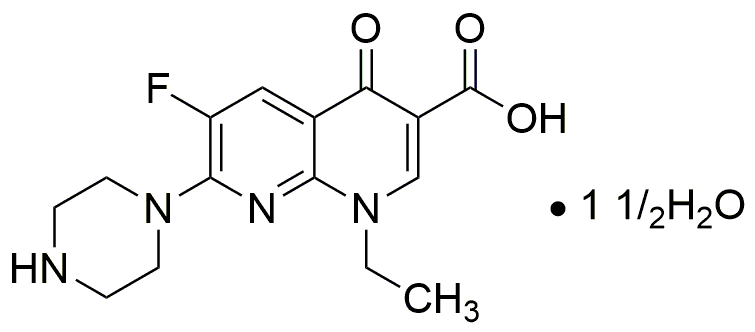Enoxacin sesquihydrate is widely utilized in research focused on:
- Antimicrobial Treatments: This compound is effective against a range of bacterial infections, making it valuable in developing new antibiotics for resistant strains.
- Pharmaceutical Formulations: Its properties allow for incorporation into various drug formulations, enhancing bioavailability and effectiveness in treating infections.
- Clinical Research: Used in studies to evaluate the efficacy of fluoroquinolone antibiotics, contributing to better treatment protocols in healthcare.
- Veterinary Medicine: Enoxacin sesquihydrate is also applied in treating infections in animals, providing a critical tool for veterinarians.
- Research on Drug Resistance: It plays a role in studies aimed at understanding and combating antibiotic resistance, helping to inform future drug development strategies.
General Information
Properties
Safety and Regulations
Applications
Enoxacin sesquihydrate is widely utilized in research focused on:
- Antimicrobial Treatments: This compound is effective against a range of bacterial infections, making it valuable in developing new antibiotics for resistant strains.
- Pharmaceutical Formulations: Its properties allow for incorporation into various drug formulations, enhancing bioavailability and effectiveness in treating infections.
- Clinical Research: Used in studies to evaluate the efficacy of fluoroquinolone antibiotics, contributing to better treatment protocols in healthcare.
- Veterinary Medicine: Enoxacin sesquihydrate is also applied in treating infections in animals, providing a critical tool for veterinarians.
- Research on Drug Resistance: It plays a role in studies aimed at understanding and combating antibiotic resistance, helping to inform future drug development strategies.
Documents
Safety Data Sheets (SDS)
The SDS provides comprehensive safety information on handling, storage, and disposal of the product.
Product Specification (PS)
The PS provides a comprehensive breakdown of the product’s properties, including chemical composition, physical state, purity, and storage requirements. It also details acceptable quality ranges and the product's intended applications.
Certificates of Analysis (COA)
Search for Certificates of Analysis (COA) by entering the products Lot Number. Lot and Batch Numbers can be found on a product’s label following the words ‘Lot’ or ‘Batch’.
*Catalog Number
*Lot Number
Certificates Of Origin (COO)
This COO confirms the country where the product was manufactured, and also details the materials and components used in it and whether it is derived from natural, synthetic, or other specific sources. This certificate may be required for customs, trade, and regulatory compliance.
*Catalog Number
*Lot Number
Safety Data Sheets (SDS)
The SDS provides comprehensive safety information on handling, storage, and disposal of the product.
DownloadProduct Specification (PS)
The PS provides a comprehensive breakdown of the product’s properties, including chemical composition, physical state, purity, and storage requirements. It also details acceptable quality ranges and the product's intended applications.
DownloadCertificates of Analysis (COA)
Search for Certificates of Analysis (COA) by entering the products Lot Number. Lot and Batch Numbers can be found on a product’s label following the words ‘Lot’ or ‘Batch’.
*Catalog Number
*Lot Number
Certificates Of Origin (COO)
This COO confirms the country where the product was manufactured, and also details the materials and components used in it and whether it is derived from natural, synthetic, or other specific sources. This certificate may be required for customs, trade, and regulatory compliance.

